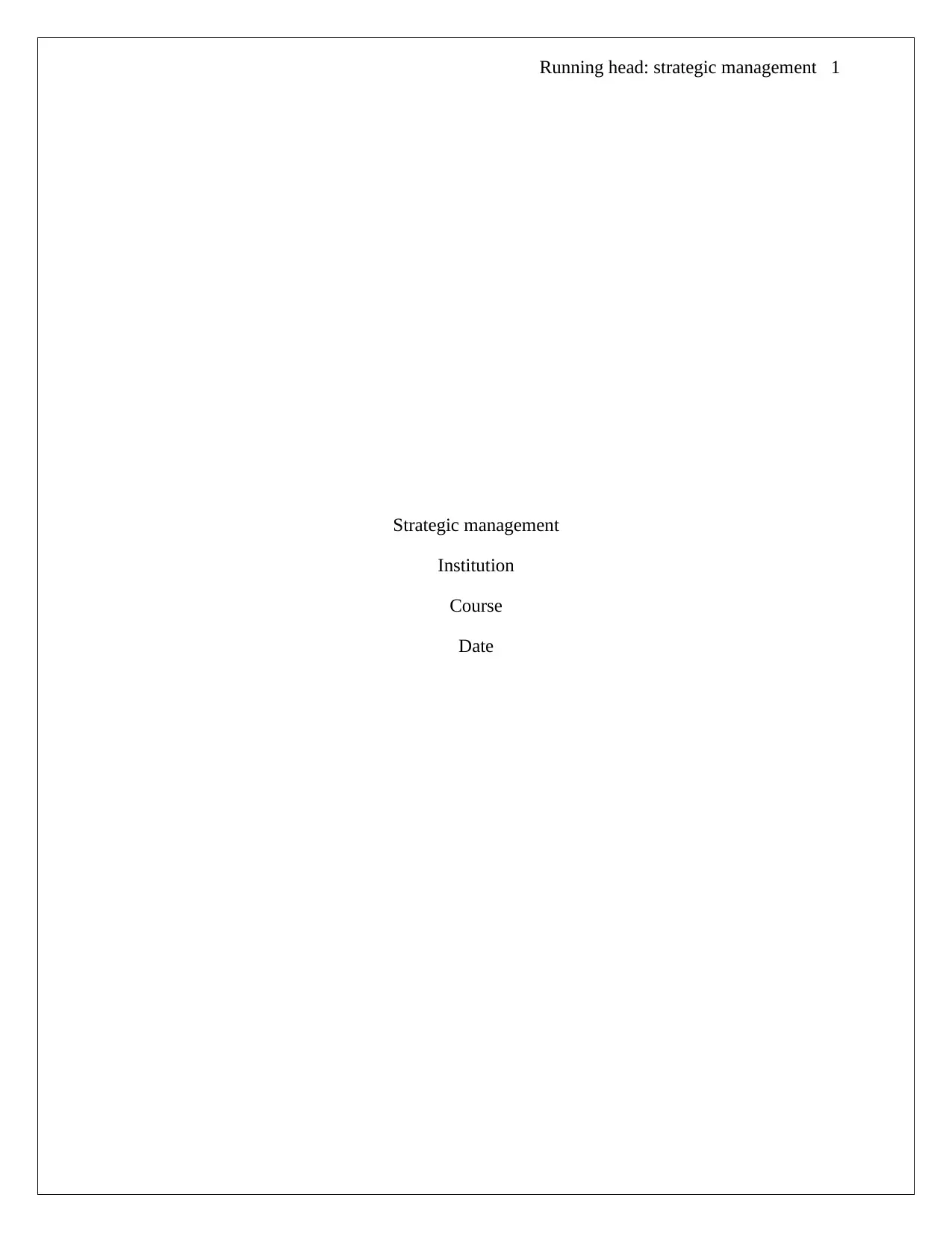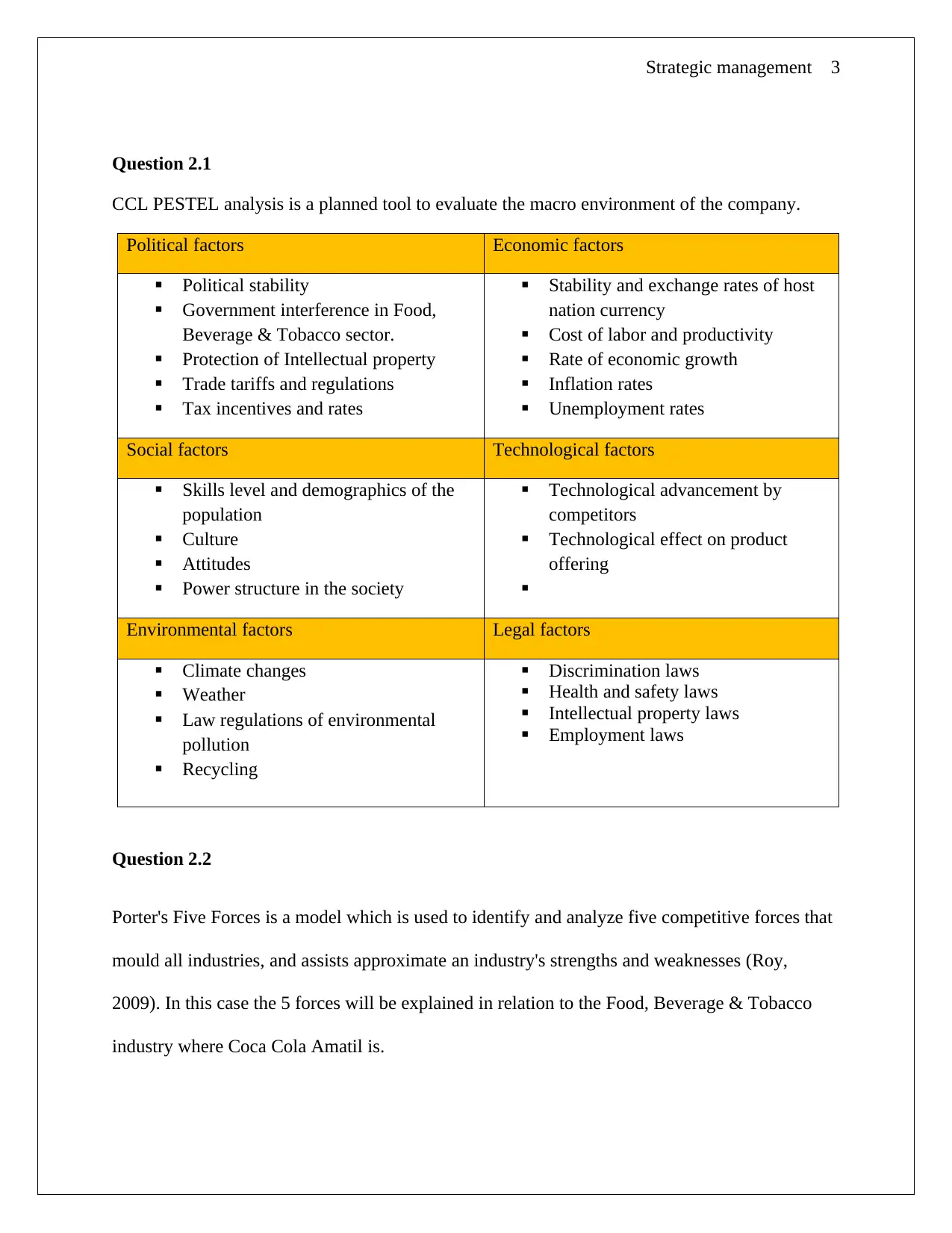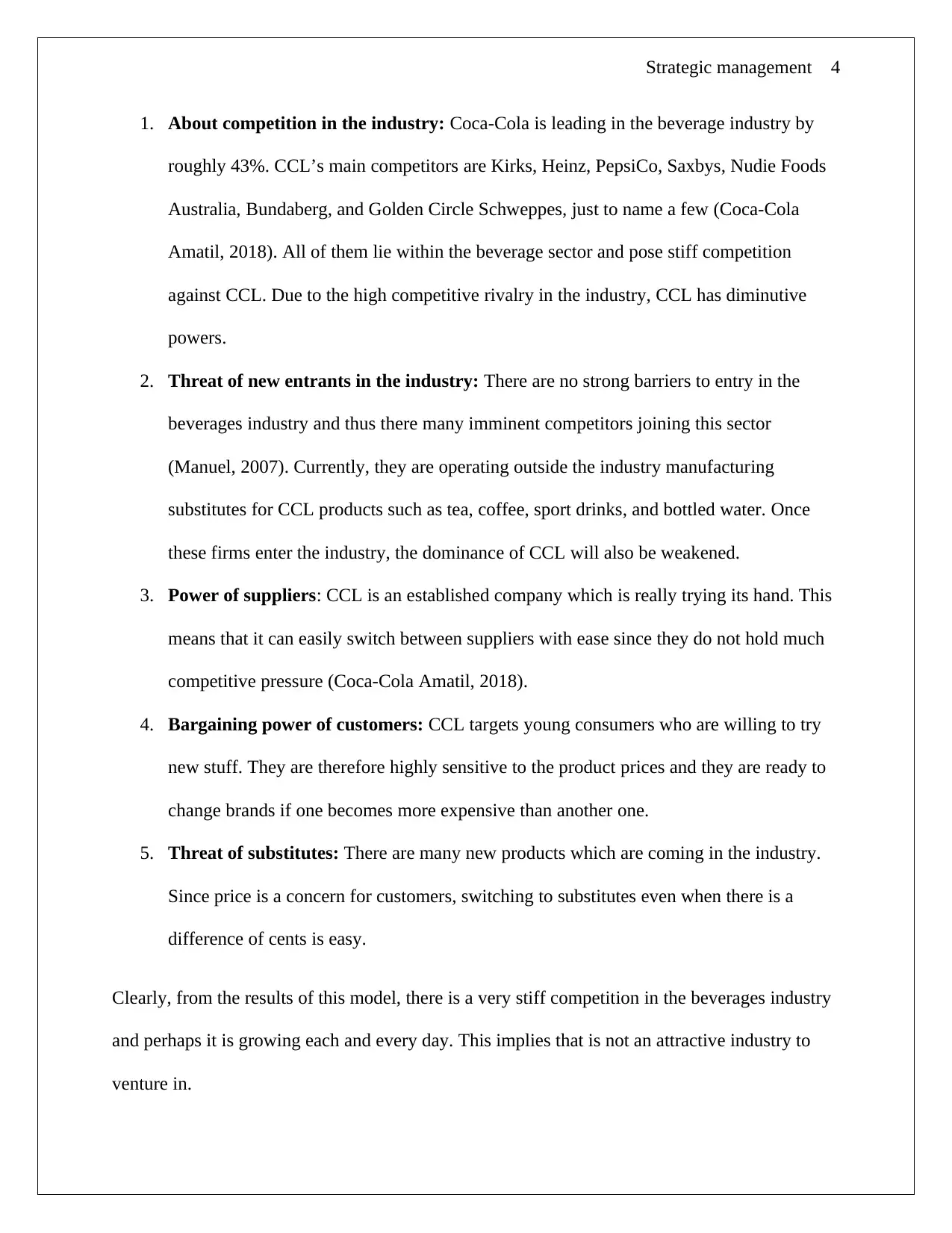MGMT 304: Strategic Analysis of Coca-Cola Amatil in Beverage Sector
VerifiedAdded on 2023/06/03
|6
|1274
|170
Report
AI Summary
This report provides a strategic analysis of Coca-Cola Amatil (CCL), examining its opportunities and threats through a SWOT analysis. It conducts a PESTLE analysis, evaluating the political, economic, social, technological, environmental, and legal factors affecting CCL. The report applies Porter's Five Forces model to assess the competitive intensity within the beverage industry, highlighting the threat of new entrants, the power of suppliers and customers, and the threat of substitutes. It identifies the growth stage of the beverage industry lifecycle and discusses the implications for competition. Finally, the report explores strategic group formation within the industry. This analysis helps understand CCL's strategic position and the competitive dynamics of the beverage market.

Running head: strategic management 1
Strategic management
Institution
Course
Date
Strategic management
Institution
Course
Date
Paraphrase This Document
Need a fresh take? Get an instant paraphrase of this document with our AI Paraphraser

Strategic management 2
Strategic Management Analysis of Coca Cola Amatil
Question 2
According to Hill, et al., (2016) SWOT Analysis provides a detailed scrutiny of a firm’s
strengths, weakness, opportunities and threats but in this case we shall only look at some of the
opportunities and threats facing Coca-Cola Amatil Ltd (CCL). They are tabulated below:
Opportunities of CCL Threats faced by CCL
Novel environmental policies
which will craft a plain playing
field for all players in this
industry. It will thus enable CCL
gain ample market share.
Lower rates of inflation– The
decreasing inflation rates will
bring more market stability, and
facilitate credit at lower interest
rates to the clients of CCL
Sprouting up of other markets due
to government agreement – the
implementation of new-fangled
technology standard and
government free trade concord
has offered CCL a chance to
venture a new up-coming market.
The current taxation policies can
considerably affect the manner of
carrying out business and can
unlock new opportunities for
reputable players such as CCL to
augment its productivity.
Liability laws are dissimilar in
different nations and CCL might be
vulnerable to a variety of liability
claims due to changes in policies in
those markets.
Current environment decrees
contained in the Paris Agreement
(2016) can be a threat to particular
existing product classes.
Scarcity of experienced labor force in
particular international markets pose
a threat to stable increase of profits
for CCL in those markets.
Mounting strengths of neighboring
distributors as well represents a threat
in certain markets as the competition
is paying higher margins to the local
distributors.
The demand of the most lucrative
commodities is by nature seasonal
and any implausible occurrence in the
peak season might affect the
productivity of the business in both
short to medium term.
Strategic Management Analysis of Coca Cola Amatil
Question 2
According to Hill, et al., (2016) SWOT Analysis provides a detailed scrutiny of a firm’s
strengths, weakness, opportunities and threats but in this case we shall only look at some of the
opportunities and threats facing Coca-Cola Amatil Ltd (CCL). They are tabulated below:
Opportunities of CCL Threats faced by CCL
Novel environmental policies
which will craft a plain playing
field for all players in this
industry. It will thus enable CCL
gain ample market share.
Lower rates of inflation– The
decreasing inflation rates will
bring more market stability, and
facilitate credit at lower interest
rates to the clients of CCL
Sprouting up of other markets due
to government agreement – the
implementation of new-fangled
technology standard and
government free trade concord
has offered CCL a chance to
venture a new up-coming market.
The current taxation policies can
considerably affect the manner of
carrying out business and can
unlock new opportunities for
reputable players such as CCL to
augment its productivity.
Liability laws are dissimilar in
different nations and CCL might be
vulnerable to a variety of liability
claims due to changes in policies in
those markets.
Current environment decrees
contained in the Paris Agreement
(2016) can be a threat to particular
existing product classes.
Scarcity of experienced labor force in
particular international markets pose
a threat to stable increase of profits
for CCL in those markets.
Mounting strengths of neighboring
distributors as well represents a threat
in certain markets as the competition
is paying higher margins to the local
distributors.
The demand of the most lucrative
commodities is by nature seasonal
and any implausible occurrence in the
peak season might affect the
productivity of the business in both
short to medium term.

Strategic management 3
Question 2.1
CCL PESTEL analysis is a planned tool to evaluate the macro environment of the company.
Political factors Economic factors
Political stability
Government interference in Food,
Beverage & Tobacco sector.
Protection of Intellectual property
Trade tariffs and regulations
Tax incentives and rates
Stability and exchange rates of host
nation currency
Cost of labor and productivity
Rate of economic growth
Inflation rates
Unemployment rates
Social factors Technological factors
Skills level and demographics of the
population
Culture
Attitudes
Power structure in the society
Technological advancement by
competitors
Technological effect on product
offering
Environmental factors Legal factors
Climate changes
Weather
Law regulations of environmental
pollution
Recycling
Discrimination laws
Health and safety laws
Intellectual property laws
Employment laws
Question 2.2
Porter's Five Forces is a model which is used to identify and analyze five competitive forces that
mould all industries, and assists approximate an industry's strengths and weaknesses (Roy,
2009). In this case the 5 forces will be explained in relation to the Food, Beverage & Tobacco
industry where Coca Cola Amatil is.
Question 2.1
CCL PESTEL analysis is a planned tool to evaluate the macro environment of the company.
Political factors Economic factors
Political stability
Government interference in Food,
Beverage & Tobacco sector.
Protection of Intellectual property
Trade tariffs and regulations
Tax incentives and rates
Stability and exchange rates of host
nation currency
Cost of labor and productivity
Rate of economic growth
Inflation rates
Unemployment rates
Social factors Technological factors
Skills level and demographics of the
population
Culture
Attitudes
Power structure in the society
Technological advancement by
competitors
Technological effect on product
offering
Environmental factors Legal factors
Climate changes
Weather
Law regulations of environmental
pollution
Recycling
Discrimination laws
Health and safety laws
Intellectual property laws
Employment laws
Question 2.2
Porter's Five Forces is a model which is used to identify and analyze five competitive forces that
mould all industries, and assists approximate an industry's strengths and weaknesses (Roy,
2009). In this case the 5 forces will be explained in relation to the Food, Beverage & Tobacco
industry where Coca Cola Amatil is.
⊘ This is a preview!⊘
Do you want full access?
Subscribe today to unlock all pages.

Trusted by 1+ million students worldwide

Strategic management 4
1. About competition in the industry: Coca-Cola is leading in the beverage industry by
roughly 43%. CCL’s main competitors are Kirks, Heinz, PepsiCo, Saxbys, Nudie Foods
Australia, Bundaberg, and Golden Circle Schweppes, just to name a few (Coca-Cola
Amatil, 2018). All of them lie within the beverage sector and pose stiff competition
against CCL. Due to the high competitive rivalry in the industry, CCL has diminutive
powers.
2. Threat of new entrants in the industry: There are no strong barriers to entry in the
beverages industry and thus there many imminent competitors joining this sector
(Manuel, 2007). Currently, they are operating outside the industry manufacturing
substitutes for CCL products such as tea, coffee, sport drinks, and bottled water. Once
these firms enter the industry, the dominance of CCL will also be weakened.
3. Power of suppliers: CCL is an established company which is really trying its hand. This
means that it can easily switch between suppliers with ease since they do not hold much
competitive pressure (Coca-Cola Amatil, 2018).
4. Bargaining power of customers: CCL targets young consumers who are willing to try
new stuff. They are therefore highly sensitive to the product prices and they are ready to
change brands if one becomes more expensive than another one.
5. Threat of substitutes: There are many new products which are coming in the industry.
Since price is a concern for customers, switching to substitutes even when there is a
difference of cents is easy.
Clearly, from the results of this model, there is a very stiff competition in the beverages industry
and perhaps it is growing each and every day. This implies that is not an attractive industry to
venture in.
1. About competition in the industry: Coca-Cola is leading in the beverage industry by
roughly 43%. CCL’s main competitors are Kirks, Heinz, PepsiCo, Saxbys, Nudie Foods
Australia, Bundaberg, and Golden Circle Schweppes, just to name a few (Coca-Cola
Amatil, 2018). All of them lie within the beverage sector and pose stiff competition
against CCL. Due to the high competitive rivalry in the industry, CCL has diminutive
powers.
2. Threat of new entrants in the industry: There are no strong barriers to entry in the
beverages industry and thus there many imminent competitors joining this sector
(Manuel, 2007). Currently, they are operating outside the industry manufacturing
substitutes for CCL products such as tea, coffee, sport drinks, and bottled water. Once
these firms enter the industry, the dominance of CCL will also be weakened.
3. Power of suppliers: CCL is an established company which is really trying its hand. This
means that it can easily switch between suppliers with ease since they do not hold much
competitive pressure (Coca-Cola Amatil, 2018).
4. Bargaining power of customers: CCL targets young consumers who are willing to try
new stuff. They are therefore highly sensitive to the product prices and they are ready to
change brands if one becomes more expensive than another one.
5. Threat of substitutes: There are many new products which are coming in the industry.
Since price is a concern for customers, switching to substitutes even when there is a
difference of cents is easy.
Clearly, from the results of this model, there is a very stiff competition in the beverages industry
and perhaps it is growing each and every day. This implies that is not an attractive industry to
venture in.
Paraphrase This Document
Need a fresh take? Get an instant paraphrase of this document with our AI Paraphraser

Strategic management 5
Question 2.3
The beverage sector is in The Growth Stage of its lifecycle (Libraries, 2018). This is
characterized by the companies’ increasing sales, higher profits, and more competitors.
Unfortunately for CCL, this stage is attracting many competitors who are entering the marketing
easily. Currently, the level of competition is at the peak with many companies producing close
substitutes or similar products as CCL. Technology is gradually facilitating of a wide array of
beverage products and therefore the current competition levels are expected to increase even
further in the future (Fairfax Media, 2014).
Question 2.4
Strategic group is a concept in strategic management which splits corporations within the same
sector with similar strategy combination and or business models (Enz, 2010). The number of
groups within a given sector and their composition entirely depends on the dimensions used to
describe them. Formation of strategic groups is quite rare in beverage industry and thus the
sector is not so prone to it.
Question 2.3
The beverage sector is in The Growth Stage of its lifecycle (Libraries, 2018). This is
characterized by the companies’ increasing sales, higher profits, and more competitors.
Unfortunately for CCL, this stage is attracting many competitors who are entering the marketing
easily. Currently, the level of competition is at the peak with many companies producing close
substitutes or similar products as CCL. Technology is gradually facilitating of a wide array of
beverage products and therefore the current competition levels are expected to increase even
further in the future (Fairfax Media, 2014).
Question 2.4
Strategic group is a concept in strategic management which splits corporations within the same
sector with similar strategy combination and or business models (Enz, 2010). The number of
groups within a given sector and their composition entirely depends on the dimensions used to
describe them. Formation of strategic groups is quite rare in beverage industry and thus the
sector is not so prone to it.

Strategic management 6
References
Coca-Cola Amatil, 2018. Coca-Cola Amatil's Competitors, Revenue, Number of Employees, Funding and
Acquisitions. [Online]
Available at: https://www.owler.com/company/ccamatil
[Accessed 4 Oct 2018].
Enz, C. A., 2010. Hospitality strategic management : concepts and cases. 2nd ed. Hoboken, N.J.: John
Wiley & Sons.
Fairfax Media, 2014. Competition concerns at Coca-Cola Amatil: analysts. [Online]
Available at: https://www.afr.com/business/banking-and-finance/investment-banking/competition-
concerns-at-cocacola-amatilanalysts-20140115-ij9fp
[Accessed 4 Oct 2018].
Hill, C., Melisaa, S. & Gareth, J., 2016. Strategic Management Theoru. 12 ed. Canada: Cengage Learning .
Libraries, 2018. 7.2 Managing New Products: The Product Life Cycle. [Online]
Available at: http://open.lib.umn.edu/principlesmarketing/chapter/7-2-managing-new-products-the-
product-life-cycle/
[Accessed 3 Oct 2018].
Manuel, E. G., 2007. The Analysis of Five Competitive Forces of Non-Alcoholic Beverage Industry and E-
Commerce Industry Cases at the Global Level. SSRN Electronic Journal.
Roy, D., 2009. Strategic foresight and Porter's five forces : towards a synthesis. München : GRIN.
References
Coca-Cola Amatil, 2018. Coca-Cola Amatil's Competitors, Revenue, Number of Employees, Funding and
Acquisitions. [Online]
Available at: https://www.owler.com/company/ccamatil
[Accessed 4 Oct 2018].
Enz, C. A., 2010. Hospitality strategic management : concepts and cases. 2nd ed. Hoboken, N.J.: John
Wiley & Sons.
Fairfax Media, 2014. Competition concerns at Coca-Cola Amatil: analysts. [Online]
Available at: https://www.afr.com/business/banking-and-finance/investment-banking/competition-
concerns-at-cocacola-amatilanalysts-20140115-ij9fp
[Accessed 4 Oct 2018].
Hill, C., Melisaa, S. & Gareth, J., 2016. Strategic Management Theoru. 12 ed. Canada: Cengage Learning .
Libraries, 2018. 7.2 Managing New Products: The Product Life Cycle. [Online]
Available at: http://open.lib.umn.edu/principlesmarketing/chapter/7-2-managing-new-products-the-
product-life-cycle/
[Accessed 3 Oct 2018].
Manuel, E. G., 2007. The Analysis of Five Competitive Forces of Non-Alcoholic Beverage Industry and E-
Commerce Industry Cases at the Global Level. SSRN Electronic Journal.
Roy, D., 2009. Strategic foresight and Porter's five forces : towards a synthesis. München : GRIN.
⊘ This is a preview!⊘
Do you want full access?
Subscribe today to unlock all pages.

Trusted by 1+ million students worldwide
1 out of 6
Related Documents
Your All-in-One AI-Powered Toolkit for Academic Success.
+13062052269
info@desklib.com
Available 24*7 on WhatsApp / Email
![[object Object]](/_next/static/media/star-bottom.7253800d.svg)
Unlock your academic potential
Copyright © 2020–2025 A2Z Services. All Rights Reserved. Developed and managed by ZUCOL.





